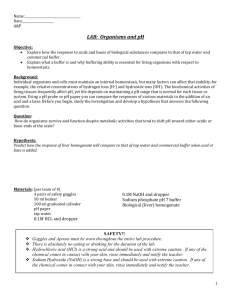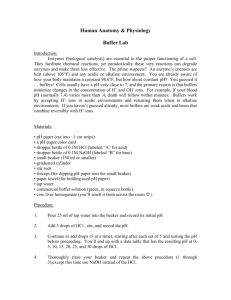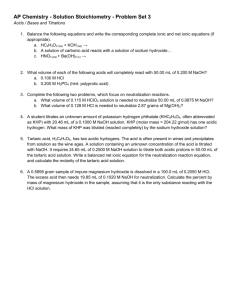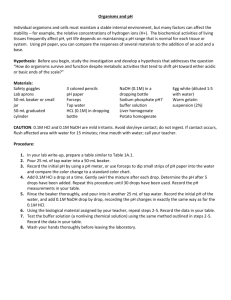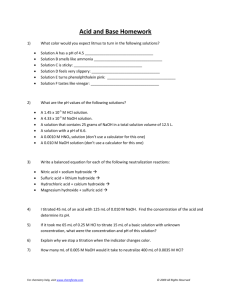pH lab - Frykberg Science
advertisement
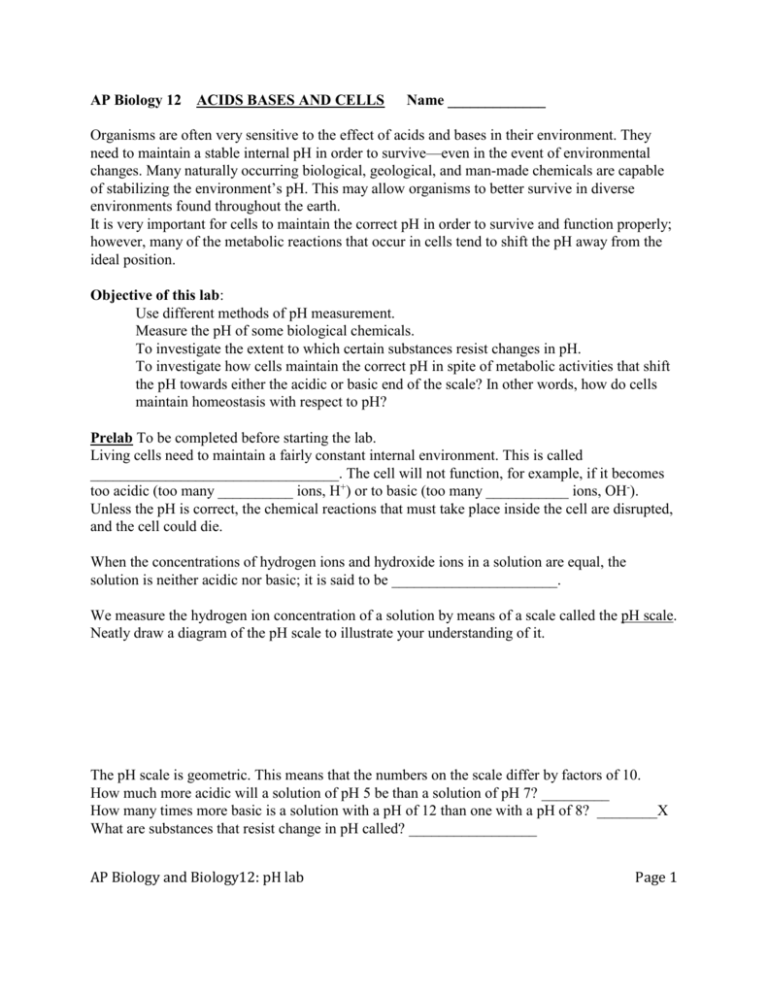
AP Biology 12 ACIDS BASES AND CELLS Name _____________ Organisms are often very sensitive to the effect of acids and bases in their environment. They need to maintain a stable internal pH in order to survive—even in the event of environmental changes. Many naturally occurring biological, geological, and man-made chemicals are capable of stabilizing the environment’s pH. This may allow organisms to better survive in diverse environments found throughout the earth. It is very important for cells to maintain the correct pH in order to survive and function properly; however, many of the metabolic reactions that occur in cells tend to shift the pH away from the ideal position. Objective of this lab: Use different methods of pH measurement. Measure the pH of some biological chemicals. To investigate the extent to which certain substances resist changes in pH. To investigate how cells maintain the correct pH in spite of metabolic activities that shift the pH towards either the acidic or basic end of the scale? In other words, how do cells maintain homeostasis with respect to pH? Prelab To be completed before starting the lab. Living cells need to maintain a fairly constant internal environment. This is called _________________________________. The cell will not function, for example, if it becomes too acidic (too many __________ ions, H+) or to basic (too many ___________ ions, OH-). Unless the pH is correct, the chemical reactions that must take place inside the cell are disrupted, and the cell could die. When the concentrations of hydrogen ions and hydroxide ions in a solution are equal, the solution is neither acidic nor basic; it is said to be ______________________. We measure the hydrogen ion concentration of a solution by means of a scale called the pH scale. Neatly draw a diagram of the pH scale to illustrate your understanding of it. The pH scale is geometric. This means that the numbers on the scale differ by factors of 10. How much more acidic will a solution of pH 5 be than a solution of pH 7? _________ How many times more basic is a solution with a pH of 12 than one with a pH of 8? ________X What are substances that resist change in pH called? _________________ AP Biology and Biology12: pH lab Page 1 Write a formal hypothesis for the following questions: (Use your textbook to refresh your memory about writing hypotheses, page 9 and 10. Remember a formalized hypothesis focuses on two variables that may be related. It makes a prediction of how manipulating one variable, independent, will affect the other variable, dependent. For example: ‘If’ and ‘then’ may be used. ) 1. Part A: What is the pH of most biological materials? ________________________________________________________________________ ________________________________________________________________________ 2. Part B: When acid or base are added to water or to a biological sample, how would the rate of change of pH compare in the two samples? ________________________________________________________________________ ________________________________________________________________________ ______________________________________________________________________ AP Biology and Biology12: pH lab Page 2 Part A. Measuring pH and Determining the pH of Some Living Materials 1. Dip pieces of blue and pink litmus paper into the solutions of 0.1 M HCl (an acid), 0.1 M NaOH (a base), tap water and distilled water. Record the colour of the indicator papers in Table 1 below. Also, use the pH indicator paper and the Vernier pH meter to measure the actual pH of the solutions 2. Use the pH indicator paper to determine the pH of each of the biological materials listed in Table 2. Record the pH of each sample, and indicate whether it is acidic or basic. Table 1. Measure pH using various indicator papers and Vernier pH meter 0.1 M HCl 0.1 M NaOH Tap water Distilled water Colour of blue litmus paper Colour of pink litmus paper pH determined from pH indicator paper pH determined from Vernier pH meter Table 2. pH of Various Living Materials Biological Sample Tested pH (use pH paper) Acidic or Basic? Saliva Tears Urine Lemon juice Milk Liver, ground Potato, ground Egg AP Biology and Biology12: pH lab Page 3 Part B. Investigating how cells maintain homeostasis in acidic and basic environments 1. Pour 25 ml of tap water into a 50 ml beaker. Record its initial pH using the Vernier pH meter. Add 0.1 M HCl one drop at a time and determine the pH after each drop has been added, until 10 drops of acid have been used. Then record the pH after every 5 drops, until 30 drops have been added in all. 2. Rinse the beaker and repeat step 1 using 25ml 0.1 M NaOH. 3. Rinse the beaker and repeat step 1 using 25 ml of liver homogenate instead of tap water. Liver is one of the most metabolically active tissues of the body and has been blended into a homogenate for your use (10 g of liver per 100 ml of water and put in a blender). 4. Repeat step 3, but use NaOH. 5. Repeat the test with potato homogenate (10 g potato blended with 100 g water). 6. Repeat the test with an inorganic solution of sodium phosphate. 7. Make a simple graph, plotting two lines for the change of pH in tap water against the number of drops of acid and base solutions added. Use a solid line for acid changes and a dashed line for changes with NaOH. On the same graph, plot the data for liver homogenate, potato homogenate, and inorganic sodium phosphate solution, using a different colour for each different solution, and solid lines for acid and dashed lines for base. Put an appropriate title on your graph. AP Biology and Biology12: pH lab Page 4 Table 3. Maintaining homeostasis in acidic and basic environments pH Measurements Number of Drops of Acid or Base Added Tap Water Liver Homogenate Potato Homogenate HCl HCl HCl NaOH NaOH NaOH Sodium Phosphate Solution HCl NaOH 0 1 2 3 4 5 6 7 8 9 10 15 20 25 30 Questions 1. List two different methods of measuring the pH of a solution. ________________________________________________________________________ ________________________________________________________________________ 2. In general, is the pH of the biological samples you tested acidic, basic or neutral? ________________________________________________________________________ 3. Use a reference to find out the pH of the following biological materials: Stomach juice __________________________________________ Intestinal juice __________________________________________ AP Biology and Biology12: pH lab Page 5 Blood 4. __________________________________________ In part B, what was the ‘control setup’? _______________________________________ What were the ‘experimental setups’? _________________________________________ _______________________________________________________________________ Why was the control setup required in this experiment? __________________________ _______________________________________________________________________ In part B, what was the ‘independent variable’? ________________________________________________________________________ What was the ‘dependent variable’? ___________________________________________ Which variable, independent or dependent, is always placed on the X-axis? _______________________________________________________________ Identify some factors that were kept constant in all the setups. ____________________________ ______________________________________________________________________________ 5. Did the biological samples (such as the liver and potato homogenates) respond in the same way as the tap water when acid or base was added. Explain. ________________________________________________________________________ ________________________________________________________________________ ________________________________________________________________________ ________________________________________________________________________ ________________________________________________________________________ AP Biology and Biology12: pH lab Page 6 6. Does the inorganic sodium phosphate solution respond to additions of acid or base more like the tap water, or more like the organic (biological) samples? Explain how you know. Did your results in this activity support your original hypothesis? ________________________________________________________________________ ________________________________________________________________________ ________________________________________________________________________ ________________________________________________________________________ ________________________________________________________________________ ________________________________________________________________________ 7. The sodium phosphate solution is called a buffer. There are many different kinds of buffers, but they all show the same property as the sodium phosphate solution when acids or bases are added. Based on your observations, do you think that there are buffers in living systems? How do you know? (Your answer must be based on your observations in this lab.) ________________________________________________________________________ ________________________________________________________________________ ________________________________________________________________________ ________________________________________________________________________ ________________________________________________________________________ 8. How do buffers affect homeostasis in a living cell when the environmental pH changes? ________________________________________________________________________ ________________________________________________________________________ ________________________________________________________________________ AP Biology and Biology12: pH lab Page 7 9. Examine the results of your experiment carefully. Can you identify any errors and if so explain the source of the errors and make suggestions as to how these can be avoided. ________________________________________________________________________ ________________________________________________________________________ ________________________________________________________________________ ________________________________________________________________________ ___________________ AP Biology and Biology12: pH lab Page 8 AP Biology and Biology12: pH lab Page 9 Biology 12: Rubric for pH and Buffer lab 4 Rubric Component Name: _______________ 3 2 1 Accurate and written with insight, goes beyond the problem. Accurate and written with insight. Accurate Partially accurate Identifies and summarizes the problem/questions at issue. Accurately identifies the problem/questions and provides welldeveloped explanations. Accurately identifies the problem/questions and provides a brief explanation. Identifies the problem/ questions and provides a poor summary or identifies an inappropriate problem/question. Does not identify or summarize the problem/questions accurately if at all. Hypothesis Clear explanation of purpose; educates by providing context. Gives a correct purpose with some framework Identifies and assesses the quality of supporting data/evidence Provides a welldeveloped examination of the evidence/data and questions its accuracy, relevance, and completeness. Clearly distinguishes between fact and opinion. Examines evidence and questions the quality. Distinguishes between fact and opinion. Identifies and evaluates conclusions, implications, and consequences Accurately identifies conclusions, implications, and consequences with a well-developed explanation. Provides an objective reflection of own assertions. Accurately identifies conclusions, implications, and consequences with a brief evaluative summary. Clarity of data tables and graphs Graph correctly titled and labeled Graph correctly titiled Graph labeled but but not labeled. contains errors in units, axes or headings. No pencil. Completion of prelab. Declares a purpose that is correct. Merely repeats information provided. Does not justify position or distinguish between fact and opinion. Does not explain, provides inaccurate information, or merely provides a list of ideas; or only discusses one area. Purpose is incorrect. Does not identify or assess the quality of supporting evidence. Does not identify or evaluate any conclusions, implications or consequences. Graph present but not titled nor labeled. Focused for entire lab/ Partly focused and followed all instructions partly cleaned up and cleaned up. Watched others and did gave instructions did not clean up. Very little participation/ mind on other things 100% Accurate Adequate Complete but inaccurate Incomplete Writing skills Full sentences, good grammar, answer the questions accurately. Full sentences, poor grammar, answers questions accurately Point form and Illegible and answers the incomplete questions accurately. Handed in on time 4 Participation during lab Research 0 Total mark: AP Biology and Biology12: pH lab Page 10

